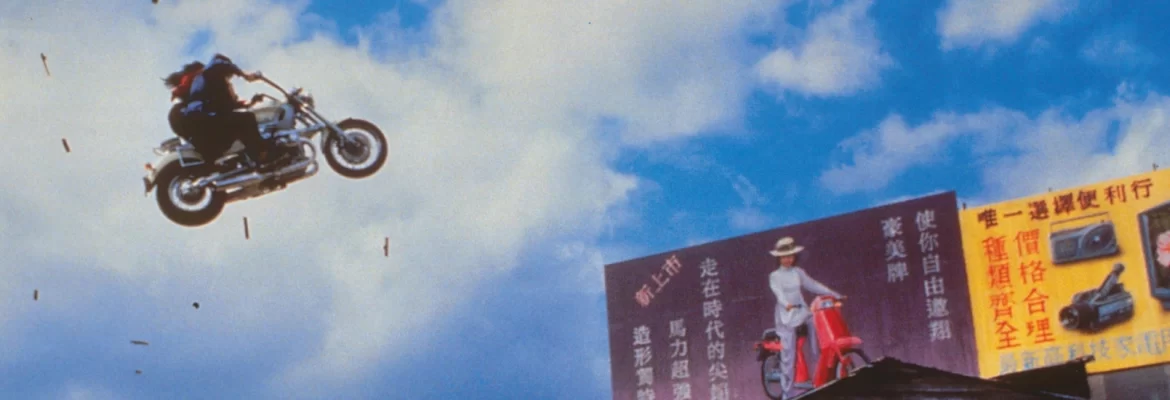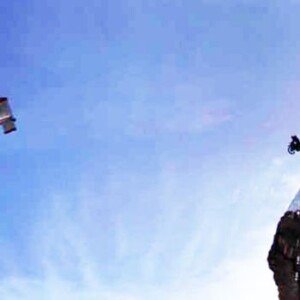Tomorrow Never Dies: The Making of the BMW Motorcycle Chase
Learn the entire process behind the BMW R1200C motorcycle chase from director Roger Spottiswoode and Second Unit Director Vic Armstrong. Plus, discover how a Vietnamese street was built at Frogmore, England complete with buildings with collapsable balconies and breakaway material for stunt work. Finally, learn how French stuntman Jean-Pierre Goy, the greatest motorcycle stuntman, made the cumbersome BMW R1200C motorcycle jump over a helicopter.
In Tomorrow Never Dies, James Bond (Pierce Brosnan) and Chinese agent Wai Lin (Michelle Yeoh) jointly ride a BMW R1200C motorcycle while handcuffed and pursued through the back alleys and rooftops of Saigon by Eliott Carver’s goons in Range Rovers and a helicopter. Here’s how it was planned and filmed.
A motorcycle setpiece was briefly planned for Goldeneye, with 007 racing through the streets of St. Petersburg. But at the time, Special Effects Supervisor Chris Corbould pointed out that there had been many great motorcycle chases in recent years, which had been the reason to cancel the sequence in Goldeneye and replace it with the iconic tank chase.
So why did EON decide on a motorcycle chase in the next film? In The Making of Tomorrow Never Dies, the film’s director, Roger Spottiswoode, said he wanted to place Bond on a vehicle completely different in size from the tank in Goldeneye.
“They had a wonderful sequence for the tank. We have to try and come up with something that’s as good. And I didn’t know how to put him in a bigger vehicle. So I thought I’d better do the opposite and put him in the most vulnerable, fragile position. And a motorcycle was that.”
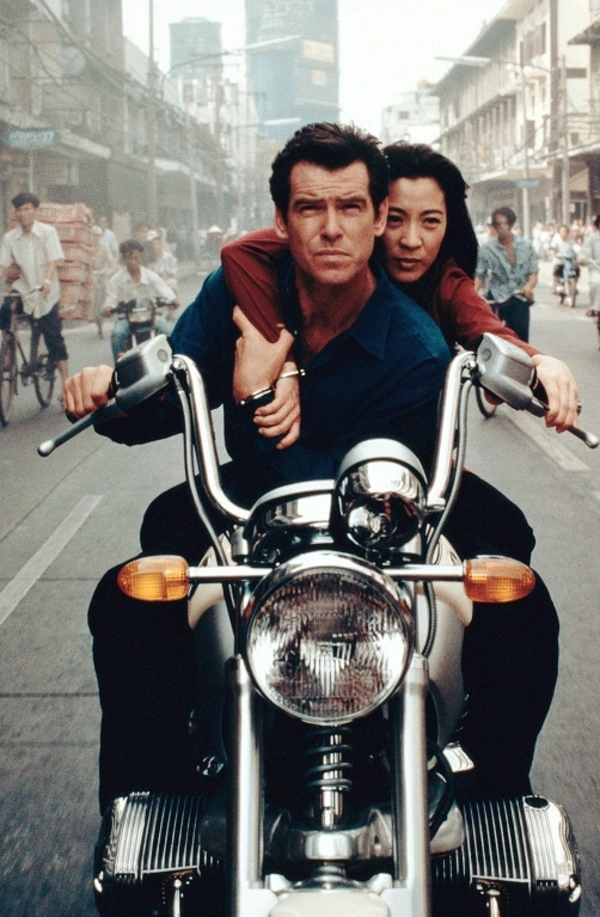
Image: Danjaq via MovieStillsDB.com
From Product Placement To One of the Best Chases in the Bond Series
The decision to put Bond on a motorcycle worked well for BMW, who took over from Aston Martin as the prime supplier of Bond’s vehicles on Goldeneye. Product placement is important in Bond films, and it went into overdrive in the follow-up to Goldeneye.
Tomorrow Never Dies was the first feature film to have its entire budget covered by money from product placement deals. And BMW paid a sizeable amount towards the film’s marketing budget.
The film could be cynically described as a commercial for premium BMW vehicles available in 1997 from the BMW 750iL sedan to the standout vehicle in the film: the BMW R1200C.
Nonetheless, the BMW car chase and subsequent motorcycle chase in Tomorrow Never Dies are some of the finest vehicle stunt sequences in the Bond series.
Bond rode the BMW R1200C before BMW released the bike to the general public, ensuring numerous sales would follow the film’s release.
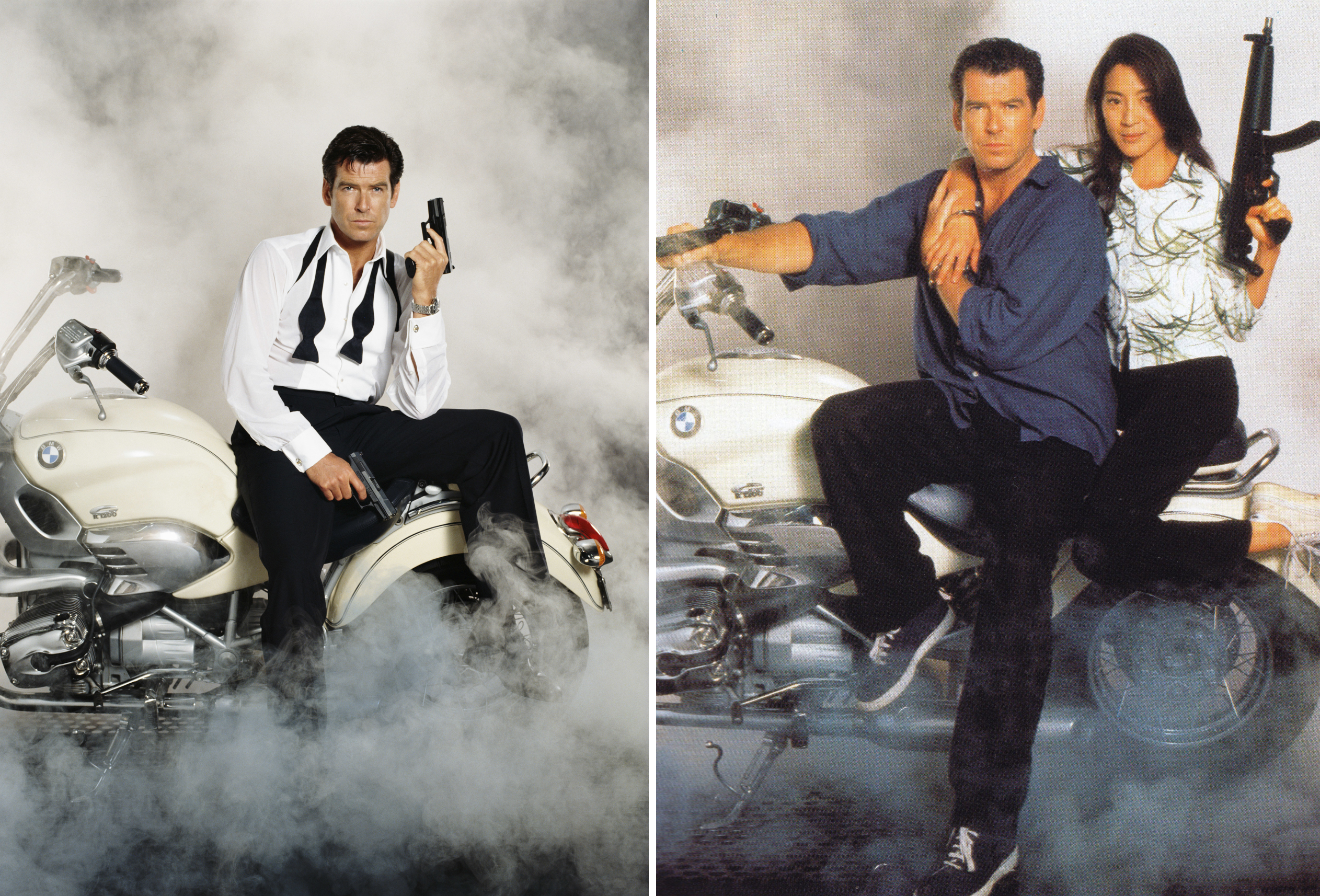
Images: Danjaq via MovieStillsDB.com
The image of Brosnan and Yeoh on the bike formed a major part of the promotional material for Tomorrow Never Dies.
The motorcycle chase was written to accommodate both male and female counterparts operating the bike. Wai Lin, a top Chinese spy is Bond’s female equivalent in Tomorrow Never Dies.
In Tomorrow Never Dies, the filmmakers handcuffed Bond and Wai Lin together ensuring they both had to ride that bike, each with a hand on the handlebars and each showcasing their skills.
Bond operated the pedals and Wai Lin popped the clutch. From a stunt perspective, two people riding a bike while handcuffed together is innovative, exciting, and fun. But the idea also works well within the context of the narrative. Bond and Lin, two agents from competing world powers, who worked from opposite ends in the film’s first half, are forced to collaborate on the motorcycle bringing them closer to working as a unified force against Carver.
There’s a nice bit of verbal byplay between the two as each initially tries to take control of the bike until they quickly decide to work together out of practicality.
Spottiswoode, using an old Hitchcock trick with actors, took Brosnan and Yeoh aside separately, and told each to get on the bike first and shot the scene with each vying for the driver’s seat after giving them conflicting directions. And that’s the take you see in the film.
Second Unit Director Vic Armstrong Devised the Stunts
While a motorcycle chase was Spottiswoode’s idea, stunt coordinator and second unit director, Vic Armstrong, devised the stunts around the locations in Thailand and on a set in Frogmore Studios, England. Of course, the stunts were worked out around the central idea of having two people handcuffed together.
Armstrong, often called “the world’s greatest stuntman” after performing stunts in some of the greatest action films, was the perfect person to assume the twin role of stunt coordinator and second unit director on Tomorrow Never Dies, a dual role he’d keep for the next two Bond films.
Armstrong decided to film in Bangkok after the crew’s visas were canceled for filming in Vietnam due to the country’s “political differences” with the UK.
Speaking with James Bond Radio, Armstrong said they found the rooftop location for the motorcycle chase in Bangkok during a location recce. To recreate the rooftop in England would have cost millions, which was the initial plan after losing Vietnam as a location.
Finding the Right Stuntman
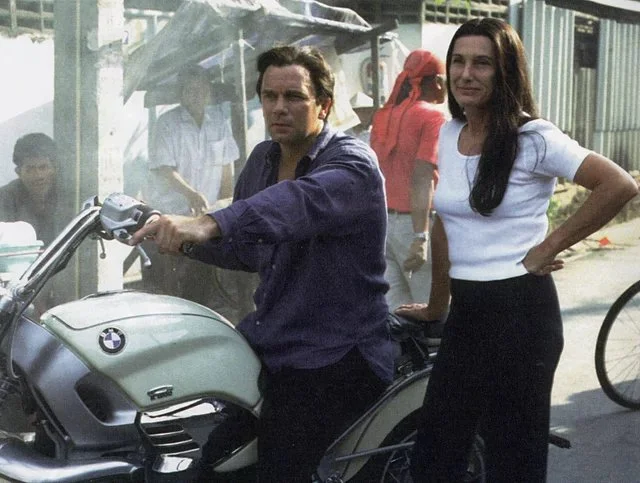
French stuntman Jean-Pierre Goy (left) performed the motorcycle stunts, including the jump over the helicopter. Wendy Leech (right), who is Vic Armstrong’s wife, doubled for Michelle Yeoh in many of the stunts except the motorcycle jump and the laydown under the helicopter. For those scenes, she was replaced with a dummy strapped to Goy’s back.
Armstrong’s wife, Wendy Leech, doubled for Yeoh during the stunts, though Yeoh performed some of those tricky maneuvers involving positioning her body on the bike to get a better look at the assailants. French stuntman Jean-Pierre Goy doubled Brosnan and performed all stunts on the bike, while Brosnan appears in some–safer–shots on the bike.
Armstrong’s brother suggested Goy perform the motorcycle stunts, but Armstrong resisted until he returned from Thailand and switched on the television.
[I]t just so happened that there was a program on about stunts, featuring Jean-Pierre Goy on his motorcycle riding up and over the handrail of this 180 foot bridge, rather like the one in A Bridge Too Far,” Armstrong wrote in his book, The True Adventures of the World’s Greatest Stuntman. “This is an omen, I thought, so I phoned him in France. He came over the next morning and we just hit it off. He was fantastic; we could not have done half the stuff in that sequence without him.”
Armstrong called Goy that night and the stuntman came over to Frogmore Studios and tested the BMW R1200C.
Featuring high handlebars, a low seat, forward-mounted legs, and a twin-engine, the BMW R1200C was a robust-built beauty weighing 10,000 pounds. While it looked great, the heavy, low-riding BMW R1200C was not built for stunts. But Goy had no problem with it.
“[I] put him on the BMW, huge BMW, which nobody ever dreamt you could wheelie or do anything with,” Armstrong told James Bond Radio. “You know, it’s 18 inches too long to wheelie. Bloody great big thing. And with somebody sitting on the handlebars and I said to him, ‘What can you do with this?’ And he just started smoking the tires. And within ten minutes he had it popped on the back wheel. Then he was doing stoppies and everything on it. And then he said, ‘Give me your stuntwoman.’ I said, ‘This is Wendy, my wife.’ [He] popped her on the handlebars. He did a wheelie with her sitting on the handlebars on this bike. Just phenomenal.”
There’s always a tension between looks and performance when selecting a vehicle for a Bond film. The vehicle needs to look the part for a debonair secret agent to drive, but the choice isn’t often the best for stunts. A lightweight dirt bike would have been better, but the convenience of characters finding the right bike for the right conditions always annoys Armstrong about action films.
The bike is used to showcase some novel stunt work.
Shooting the Motorcycle Sequence
On May 14th, 1997, the first and second units traveled to Bangkok, Thailand to film the sequence.
The first unit headed by Spottiswoode filmed shots of Brosnan and Yeoh on the bike, while the second unit under the control of Armstrong filmed the stunts.
The BMW R1200C motorcycle sequence was rehearsed for two weeks before shooting began. The sequence up to the jump across the helicopter was mostly filmed around Mahogany Wharf, Bangkok, in a strip that Armstrong nicknamed “Tannery Row” and “Smelly Alley” after the stench from the nearby tanning of animal hides.
Back in England, Production Designer Allan Cameron turned the old Radlett Aerodrome site in Frogmore, Hertfordshire into the backstreets and rooftops of Saigon in Tomorrow Never Dies, primarily to film three big stunts in the motorcycle sequence:
- Bond and Wai Lin jump from rooftop to rooftop over a helicopter.
- Ledges and balconies break away as the heavy bike drives over them.
- The ground-level chase by a tilted helicopter and the helicopter’s subsequent explosion.
BMW provided the production with fifteen R1200C bikes, 12 of which were destroyed during production. Each bike was valued at $13,000, which proved to be a small investment for the car company.
There are plenty of mid shots of Brosnan and Yeoh on the bike, but they’re deceptive. Brosnan and Yeoh were filmed on stationery bikes moved by the crew or towed by special rigs, such as a rig that pivoted the motorcycle on its axis in a perfect 90-degree arc, as seen below.

Brosnan and Yeoh also sat on half a bike: the top half –the front headlight, handlebars, and seat—attached to a special rig mounted on a trailer towed by a quad bike through the alleyways, backstreets, and rooftops of Bangkok, as below.

The BMW R1200C Jumps Over A Helicopter
The centerpiece of the sequence is the jump over a helicopter, which was filmed on July 24th, 1997, back at Frogmore.
Armstrong briefly considered using CG, optical effects, and cables, but Jean-Pierre Goy said he could do the stunt for real.
Goy would jump the BMW bike from the top story of a building over the helicopter and through the roof of another building on the other side of the street. The buildings were part of the street built at Frogmore, which allowed for the stunt to be as controlled and safe as possible.
To ensure safety, the facade of the building Goy exits on the bike and the front and roof of the building he enters on the other side were made from breakaway material.
The breakaway material had been extended to the front of the building he was meant to land on in case the motorcycle’s engine misfired and he fell short and hit the front of the building.
The prop helicopter was affixed in place by a hydraulic lift which allowed it to be moved up, down, and around. The effect of the hydraulic lift can be seen in the shot of the helicopter lowering between the two buildings, while Bond contemplates the jump.
For the jump, the hydraulic lift remained stationary, holding the helicopter in place, with the spinning rotors added digitally in post-production to prevent the stuntman from being diced if anything went wrong.
“He had to reach a speed of 62 mph in 5.8 seconds, hit a wooden ramp, crash through a balcony in a five-storey building, clear a street of 45 feet, and drop 12 feet onto a roof opposite cushioned with a 20-foot mountain of cardboard boxes,” Armstrong recalled in The True Adventures of the World’s Greatest Stuntman. “In all we used 10,000 boxes, all specially made, and when it rained we had to wrap them in plastic; what a nightmare.”
Goy performed the jump with a dummy, doubling as Wai Lin, strapped to his back. He’s the first and only stuntman to attempt this stunt on a heavy motorcycle like the BMW R1200C.
Riding on Breakaway Balconies
After Bond and Wai Lin make their jump over the helicopter, they exit the building they landed on via a balcony.
Sections of the balcony collapse behind the heavy motorcycle, and Bond and Wei Lin drive from the balcony onto a trailer of conveniently placed product placement: cans of Heineken.
Armstrong’s son, a welder and engineer on Tomorrow Never Dies, built the collapsing balcony for Special Effects Supervisor Chris Corbould.
“This is very clever,” Armstrong mentioned in the film’s audio commentary. “We had safety wires on them in case one of the balconies went prematurely. They [Goy and Leech] could drop the bike and still be hanging there. Very cleverly worked out.”
Helicopter Chases Bond and Wai Lin At Street Level
The idea of a helicopter tilting and chasing a motorcycle at steel level is nonsense, but it’s nonsense that works well in the world of 007.
It all comes down to suspension of disbelief mastered over decades by the special effects team at EON.
“We agonized … for weeks on how we were going to bring the helicopter down without making it look too ridiculous,” Armstrong explained on the Tomorrow Never Dies: Ultimate Edition audio commentary.
The same helicopter that Goy jumped over was used in this sequence. It was still attached to the hydraulic lift, which, in this scene, moved along a special track along Cameron’s recreated Vietnamese street at Frogmore Studios.
Once again, the helicopter’s rotors were added digitally in post.
The difficulty for the CG crew was making the digital rotors hit real objects in the street, so it all looked real on screen.
“Every bullet hit you can see we had to time out when they had to go so it times in with the helicopter’s spinning blades hitting the stalls,” Armstrong said in the film’s audio commentary. “Plus these are real Vietnamese people which hadn’t worked in a movie before. So we spent two weeks working with rehearsing them, explaining the dangers, and they were very very good, I must say.”
Wind turbines simulated the air generated by the helicopter’s blades for shots of Brosnan and Yeoh on the titled bike, which is the position the bike must take to slide underneath the helicopter, a stunt performed by Goy with a perfect laydown.
The scene does feature one error. Yeoh couldn’t extend her left arm and hand to hold the motorcycle’s left handlebar. Looking closely, you can see a fake arm extending from her real arm onto the handlebar. It’s a glaring error in an otherwise stunning action sequence.
Armstrong’s creation of exciting, wall-to-wall action on Tomorrow Never Dies secured his return as Second Unit Director on Brosnan’s remaining two Bond films, The World Is Not Enough and Die Another Day, on which he continued to develop interesting and unique action sequences that helped raise the bar for action films in the Nineties and beyond.

